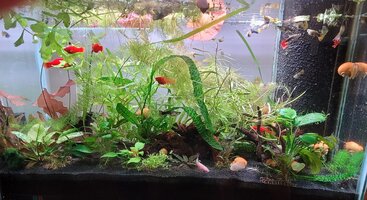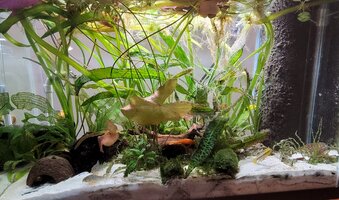I have two 29 side by side and one (both low tech); both have the same hardware with the primary difference in fish population and substrate. One can grow plants quite successfully and has little problem with decay or adverse algae such as bba (the black one); the other has frequently problem with decay esp in floating plants and areas of bba. I've been assuming this is due to the substrate in some fashion as the white one does get some compression and some sulfur gas build-up and have been contemplating as an experiment tearing it down and replacing the substrate with the same stuff in the 'good' tank. The black substrate is slightly coarser and 'waste' tends to settle on top my only tiny reluctant in replacement (other than work) is that the apisto and kuhli likes digging in the white stuff (the white stuff is caribsea moonlight which from their website is quite powdery fine - the black substrate is estes stoney river and they email me the grain size and it is a bit coarser but not huge but in working with both tanks over the past 18 months it has a different behavior in how stuff like waste mixes in it (it mostly settles on the surface for example).
Examples of some of the difference is that in the black tank hornworth grows very cleaning and quite nicely while in the white tank it becomes a brown smudge over time and eventually has to be removed and toss. The frogbit in the white tank develops a brown smudge in the roots and has a bit of a foul smell while in the black tank they stay crystal clean and without issue.
I'm presuming the issue is with the substrate but perhaps it is some other issue I simply do not understand hence this post:
(I do 50% water change on this two tanks twice a week over the past 18 months)


Examples of some of the difference is that in the black tank hornworth grows very cleaning and quite nicely while in the white tank it becomes a brown smudge over time and eventually has to be removed and toss. The frogbit in the white tank develops a brown smudge in the roots and has a bit of a foul smell while in the black tank they stay crystal clean and without issue.
I'm presuming the issue is with the substrate but perhaps it is some other issue I simply do not understand hence this post:
(I do 50% water change on this two tanks twice a week over the past 18 months)




